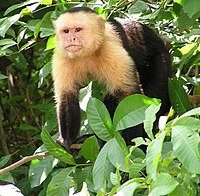Gracile capuchin monkey
| Gracile capuchin monkey[1] | |
|---|---|

| |
| White-headed capuchin (Cebus capucinus) | |
| Scientific classification | |
| Kingdom: | |
| Phylum: | |
| Class: | |
| Order: | |
| Family: | |
| Subfamily: | |
| Genus: | Cebus Erxleben, 1777
|
| Type species | |
| Cebus capucinus Linnaeus, 1758
| |
| Species | |
|
Cebus albifrons | |
Gracile capuchin monkeys are capuchin monkeys in the genus Cebus. At one time all capuchin monkeys were included within the genus Cebus. In 2011, Jessica Lynch Alfaro et al. proposed splitting the genus between the robust capuchin monkeys, such as the tufted capuchin, and the gracile capuchins.[1] The gracile capuchins retain the genus name Cebus, while the robust species have been transferred to Sapajus.[1][2]
Species and subspecies
Following Groves (2005), taxa within the genus Cebus include:[3]
- White-fronted capuchin, Cebus albifrons
- Ecuadorian capuchin, Cebus albifrons aequatorialis
- Cebus albifrons albifrons
- Shock-headed capuchin, Cebus albifrons cuscinus
- Trinidad white-fronted capuchin, Cebus albifrons trinitatis
- Cebus albifrons unicolor
- Varied capuchin, Cebus albifrons versicolor
- White-faced or white-headed capuchin, Cebus capucinus
- Kaapori capuchin, Cebus kaapori
- Wedge-capped capuchin, Cebus olivaceus
Some authorities recognize additional subspecies of C. capucinus and C. olivaceus.[4][5]
Range
Gracile capuchin monkeys have a wide range over Central America and north and north-west South America. The white-headed capuchin is the most northern species, occurring in Central America from Honduras to Panama, and also in Colombia and Ecuador west of the Andes.[4] The white-fronted capuchin is found over large portions of Colombia, Peru and western Brazil, as well as into southern Venezuela and northern Bolivia.[6] The weeper capuchin is found over much of Venezuela and over The Guianas, as well as part of northern Brazil.[5] The Kaapori capuchin has a range that is disjoint from the other gracile capuchins, living in northern Brazil within the states of Pará and Maranhão.[7]
Taxonomic history
Philip Hershkovitz and William Charles Osman Hill published taxonomies of the capuchin monkeys in 1949 and 1960, respectively.[1] These taxonomies established four species of capuchin monkey in the genus Cebus. One of those species, Cebus apella, is a robust capuchin and is now included in the genus Sapajus. The other three Cebus species included in that taxonomy were the gracile capuchin species Cebus albifrons, Cebus nigrivittatus and the type species Cebus capucinus.[2] Cebus nigrivittatus was subsequently renamed Cebus olivaceus.[2][5] Cebus kaapori had been considered a subspecies of C. olivaceus but Groves (2001 and 2005) and Silva (2001) regarded it as a separate species.[7]
Conservation status
All gracile capuchin species except the Kaapori capuchin are rated as least concern by the International Union for the Conservation of Nature.[4][5][6] The Kaapori capuchin is rated as critically endangered.[7]
Differences from robust capuchins
The gracile capuchins, like all capuchins, are members of the family Cebidae, which also includes the squirrel monkeys. The evolution of the squirrel monkeys and capuchin monkeys is believed to have diverged about 13 million years ago.[1] According to genetic studies led by Lynch Alfaro in 2011, the gracile and robust capuchins diverged approximately 6.2 million years ago.[1][2] Lynch Alfaro suspects that the divergence was triggered by the creation of the Amazon River, which separated the monkeys in the Amazon north of the Amazon River, which evolved into the gracile capuchins, from those in the Atlantic Forest south of the river, which evolved into the robust capuchins.[1][2]
Gracile capuchins have longer limbs relative to their body size compared with robust capuchins.[1] Gracile capuchins also have rounder skulls and other differences in skull morphology.[1] Gracile capuchins lack certain adaptations for opening hard nuts which robust capuchins have.[1] These include differences in the teeth and jaws, and the lack of a sagittal crest.[1] Exterior differences include the fact that, although some females of C. albifrons and C. olivaceus have tufts on their head, no male gracile capuchin has tufts, while all robust capuchins have tufts.[1] Also, no gracile capuchins have beards.[1]
Tool use
Some gracile capuchins are known to use tools. These include white-headed capuchins rubbing secretions from leaves over their bodies, using leaves as gloves when rubbing fruit or caterpillar secretions and using tools as a probe.[1][8] White-fronted capuchins have been observed using leaves as a cup to drink water.[8]
References
- ^ a b c d e f g h i j k l m n Lynch Alfaro, J.W.; Silva, j.; Rylands, A.B. (2012). "How Different Are Robust and Gracile Capuchin Monkeys? An Argument for the Use of Sapajus and Cebus". American Journal of Primatology: 1–14. doi:10.1002/ajp.222007.
- ^ a b c d e Lynch Alfaro, J.W.; et al. (2011). "Explosive Pleistocene range expansion leads to widespread Amazonian sympatry between robust and gracile capuchin monkeys" (PDF). Journal of Biogeography. doi:10.1111/j.1365-2699.2011.02609.x.
- ^ Groves, C. P. (2005). Wilson, D. E.; Reeder, D. M. (eds.). Mammal Species of the World: A Taxonomic and Geographic Reference (3rd ed.). Baltimore: Johns Hopkins University Press. ISBN 0-801-88221-4. OCLC 62265494.
- ^ a b c Template:IUCN2011.2
- ^ a b c d Template:IUCN2011.2
- ^ a b Template:IUCN2011.2
- ^ a b c Template:IUCN2011.2
- ^ a b Garber, P.A., Gomez, D.F. & Bicca-Marques, J.C. (2011). "Experimental Field Study of Problem-Solving Using Tools in Free-Ranging Capuchins (Sapajus nigritus, formerly Cebus nigritus)". American Journal of Primatology. 74 (4): 344–58. doi:10.1002/ajp.20957. PMID 21538454. Retrieved 2012-03-18.
{{cite journal}}: CS1 maint: multiple names: authors list (link)


